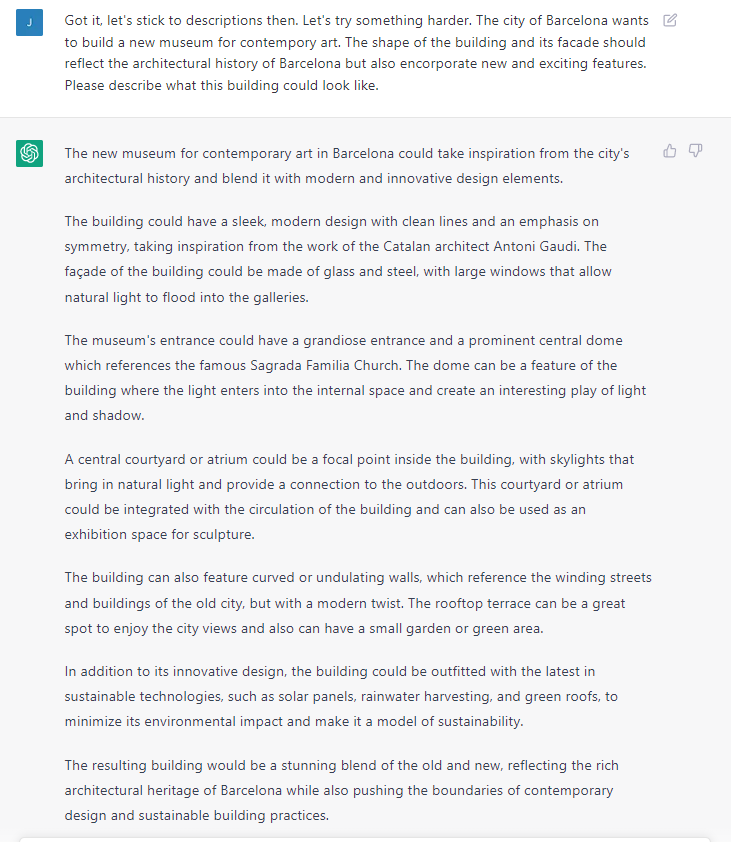"I can design a building" ChatGPT confidently proclaims...
It started with a LinkedIn post about the power of the soon-to-be-released ChatGPT-4 API. Chat GPT is one of the products of start-up OpenAI, which don't fail to cause excitement online since their first release of DALL-E in 2022. ChatGPT is a chatbot based on a large language model, that has proven to garner attention for its quick and detailed responses and knowledge across many domains. So when I saw the post about the potential of its newest version's API, I began to wonder what that could mean for the AEC industry. In the first moment I couldn't really see any use cases for a language synthesizer in our technical world made up of numbers and images. So I turned to ChatGPT and asked it directly - what benefit do you think you could bring to the architecture and construction industry?
Applications of ChatGPT within architecture and construction
ChatGPT unsurprisingly wasn't short of answers. Confidently it proclaimed:
Yes, there are several ways that the architecture and construction sector could benefit from a GPT-3 integration.
As the first example it brought up the generation of building design options. Based on a set of input parameters and requirements from an architecture firm, it said it could design options for a building project. Providing multiple options "complete with floor plans, elevations, and 3D renderings" would be no problem, it stated. Another application would be the automated generation of reports, specifically for safety inspections and auditing. It ended its response in stating that this were only two of many applications of GPT-3 in our industry, which again made me admire its assertiveness. However, the idea of generating design options made me curious.
Generating building designs with ChatGPT
I was wondering how a language model would come up with drawings and even 3D models of a building project. However, it didn't seem so worried about that. It responded it would either generate a description that would then be interpreted by a not-further-defined software to create the visual components or it would communicate directly with another AI "such as computer vision and Generative Adversarial Networks" to create the visual representation.
Fair enough, I thought. Let's put this to the test then. I gave it the task to design a simple single floor residential building: 2 bedrooms, 1 kitchen, 1 living room and 1 bathroom. Rooms can be connected via a hallway where necessary and the layout shall be optimized for short walking distances between the rooms.
This is the reply I got:
I was surprised that the chatbot instantly started typing out its response seemingly any time needed for calculations or "thinking". On first glance its description of the house sounds sensible and it had definitely taken my requirements into account. All the rooms were located and connected by a short hallway. It even tried to account for other factors like "easy access" by placing the bathroom close to the main entrance. However, when I tried sketching the floorplan out I had trouble placing the rooms in the order it described. Both bedrooms next to each other while also facing the backyard seemed hard and placing kitchen and bathroom next to the living room which is also supposed to make up most of the right side of the building was impossible.
It seemed like the algorithm was excellent at generating smart sounding text rather than solving the problem at hand. This was further solidified when I asked it for the coordinates of the corners of each room. It told me as a language model AI it didn't have the capacities to provide coordinates or generate 3D models. It suggested I look into software for Building Information Modeling (BIM), which had me chuckling a little.
The Twitter community seemed to agree that with its pure language based capabilities it wasn't going to solve challenges in our industry. However, I wanted to put it to another test. Maybe designing a floor plan was too technical of a challenge. A facade could be easier to describe and a change for ChatGPT to let its creative powers shine. So I asked it to design the external appearance of a new museum for contemporary art in Barcelona. The building was to reflect the architectural history of Barcelona while still incorporating new and exciting features.
Again ChatGPT wasn't short for answers and typed out a lengthy description of its idea for the new museum. It ended in proudly stating that its design was "pushing the boundaries of contemporary design and sustainable building practices". So let's take a look at its answers.
Even though, it's a robot, I still feel bad for making fun of it. So, we're not going to focus too much on the "sleek, clean lines" of Gaudi or the "famous" central dome of the Sagrada Familia Church. I mean, overall it had some nice ideas. So let's visualise them using its sibling app DALL-E.
DALL-E is a text-to-image AI developed by OpenAI. It will generate an image to a given prop. So I fed a shortened version of the museum description to DALL-E and asked it to generate images in the style of architectural renderings.
Below you find a selection of the better of images generated by DALL-E. I guess the main take away of this exercise is: if you were worried about AI taking your job, maybe don't worry just yet...






